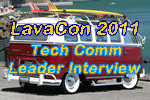 I sat down with Andrea Ames of IBM for a serious chat about content strategy and user experience at Lavacon 2011. Andrea has been in the DITA/content strategy trenches for longer than most of us have known what XML means and if I sound impressed at any point, it’s because I am. She’s not only had the time to think things through but has also implemented some fantastic solutions that most of us would consider something that can’t yet be done.
I sat down with Andrea Ames of IBM for a serious chat about content strategy and user experience at Lavacon 2011. Andrea has been in the DITA/content strategy trenches for longer than most of us have known what XML means and if I sound impressed at any point, it’s because I am. She’s not only had the time to think things through but has also implemented some fantastic solutions that most of us would consider something that can’t yet be done.
When I asked her how she started in this role, she said “I felt like the first victim of my products. Why don’t we make the product better before mitigating damage by documenting poorly designed products?” Way back in 1989, her focus of a master’s degree was the intersection between technical communication and cognition. She was studying how users think about and process online information systems. The user experience of documentation. What a novel idea.
We talked a lot about why documentation falls so short of what users need, so often. Are people just dumb? Not thinking? Lazy?
Well, no. At least not on purpose. The company and the management have to support the writers. Andrea identified some reasons for poor user experience of documentation, including:
- Lack of appropriate tools and infrastructure.
- Development process that doesn’t include time for information architecture review (has to be before code complete).
- Authors are too timid, and don’t know how to escalate an issue of bad design properly so that it gets fixed instead of documented.
- Not backing up arguments with actual metrics (in other words, do the research first).
- No champion for the cause.
- No evaluation of user experience.
- No metrics/feedback from users. Hint: Listen to support, they might be able to identify important trends in user experience that might otherwise be missed (such as all new users have trouble with a widget but everyone else is using something else).
- Lack of training for writers, including practical hands-on stuff such as how to handle developers. The weakness is in soft skills—political, leadership, and process skills—where writers lack training. Managers need to build capability in the team.
- Product management fails to define user scenarios and get them validated. They’re also not coming to content providers when they do get valid scenarios (there’s a disconnect).
- General lack of resources sometimes means that user stories are just not getting done/validated.
So there are some good excuses for a poor user experience, but nothing that can’t be overcome.
We also quickly discussed the role of DITA in the user experience of content strategy.
Ames put it simply: “One key to an excellent information experience is metadata in your content, typically through XML. The metadata allows you to customize the information. Users then set their preferences in the user interface, then they get a customized output, like a PDF, that is meant just for them. So what would originally have been 1500 pages and included content for all kinds of users is now 50 pages of content specific to a particular user.”
Our conversation inevitably turned to DITA tactics. I wanted to know how IBM develops its content model to meet the end goals.
“We developed a componentized content model, where we use a DITA map as a component map. Topics get collected into atomic units. It’s the largest number of topics that always travel together. The purpose of the component map is also for the authors, not just for assembling the user deliverables: to define components, to identify the atomic units of a feature.”
When asked about how to go about creating a good user experience strategy, Ames said “It’s important to define the end user experience first and then build the content strategy from there. Not the other way around. And don’t forget that it’s an iterative process. You’re always going back and improving your strategy, your tools, and tweaking the end results. More importantly, you always need to be getting more feedback from users, because they’re the ones who will tell you what they want and need.”
So, what’s the holy grail of content experience? We’re developing a strong content strategy and comprehensive DITA tactics. What are we aiming for?
“User scenarios can drive great user interface development, providing content that’s useful right inside the product. From there, the documentation augments the user interface but is user goal-based rather than feature based. Which is uber useful. Content strategy requires creating user scenarios, which include steps for validating and gaining goal-based understanding of users.”
I asked Ames about the difficulty in getting user feedback, especially in determining their real goals. I wanted to know if technical communicators could “fake” the feedback.
“You can fake it and have it work by making educated guesses. If you do that, it’s the feedback you get from those guesses that can then get the ball rolling, where you’ll get the actual user feedback you want and need.”
Ames has a definite vision for the field of content strategy and experience ten years down the road.
“A brain-implanted chip. Instant information. Heard of the Nuremburg funnel?”
Look for more information from Andrea Ames on the user experience of content in the May, June, and September 2011 archives from Intercom, in an upcoming special edition of Intercom, and in some upcoming models presented to the STC.